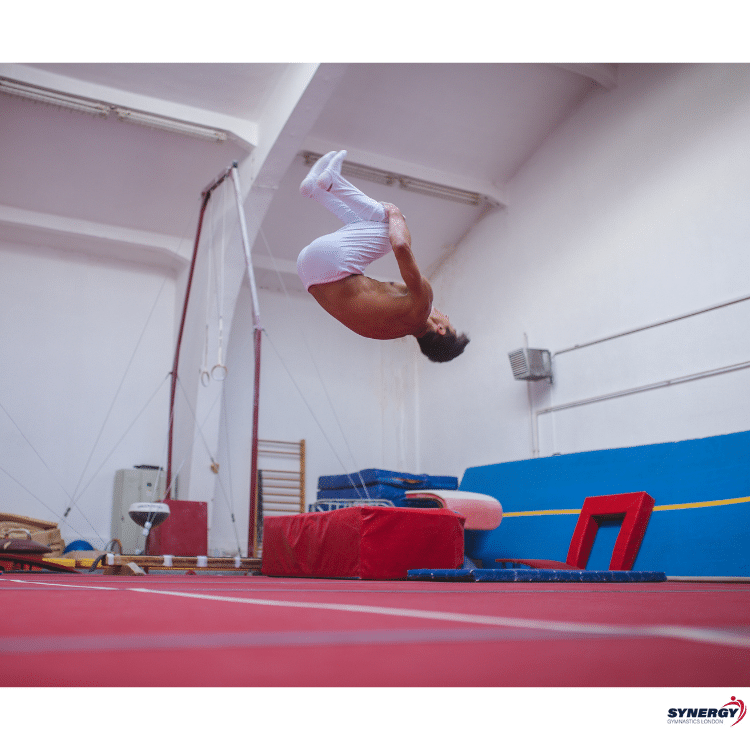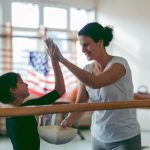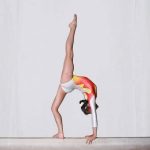
The Full In is a gymnastics skill performed in Artistic, Tumbling, and Trampoline gymnastics. It involves a double somersault with a full twist during the first somersault.
This guide will explore everything you need to know about the Full In, from its variations to it’s progressions.
What is a Full In Gymnastics?
In gymnastics, a Full-in is a gymnastics skill that combines a double backflip with a full twist. It is one of the more challenging moves in gymnastics, and definitely not one for beginners to attempt.
There are different terms that describe the same skill: Full Twisting Double and Back-out are both terms used to describe the Full-in.
The key thing to look out for is the full twist happening in the first somersault. The second somersault can be performed in different shapes:
- Tuck
- Pike
- Puck (open tuck)
- Straight
If the gymnast adds another twist in the second somersault, it becomes a Full-full.
If the twist occurs only in the second somersault, it is called a Full-out.
Similar Skills to the Full In
Twisting somersault terminology can vary:
- A Full: Single somersault with a full twist. Also known as a full twisting layout.
- A Full-out: Double somersault with the twist in the second somersault.
- A Half In Half Out: Double somersault with half the twist in each somersault.
Terms can be used interchangeably depending on region, country or even particular gyms.
How to Perform a Full-in
This should be considered general advice and not be confused with professional coaching in a recognized environment with safety mats. Please do not attempt a full in at home or without qualified support.
Executing a Full In requires a confident double somersault and a high full twisting single somersault to be achieved first. Here are the steps to follow when performing a Full In Tucked on the floor or tumble track:
- Start by sprinting into a Round off then immediate Back Handspring.
- Snap the feet down quickly so they contact the floor behind the hips. Keep shoulders pressed down.
- Lift the hips, chest and arms into the take-off for the somersault.
- Start the twist by pressing the chin into one shoulder and wrapping the arms into the chest and rolling the opposite shoulder and hip across the body.
- Around three-quarters through the twist tuck the legs and hips up and over, grabbing the front of the legs in the process.
- Without throwing the head back, try to spot the landing as early as possible
- Extend your legs and land on the mat with your feet shoulder-width apart.
These steps would be slightly adapted if performing the Full In on Beam, Trampoline or as a dismount from bars or rings. When I teach the full-in I use the timing of three-quarters twist as it helps the gymnast get the timing of changing into the second somersault more effectively. If they complete the full twist completely and then change shape, I often find they start the second somersault too late and lose height and momentum.
When performing more advanced moves like the Full In it is important to have a good understanding of the biomechanics and physics at work during the skill.
Common Mistakes to Avoid When Performing a Full-in
- Not maintaining enough momentum when sprinting towards the springboard.
- Failing to tuck your arms in tightly when performing the double backflip.
- Starting the full twist too early or too late.
- Failing to extend your legs when landing, which could result in injury.
Training for a Full-in
Training for a Full-in requires a combination of strength, skill, and precision. Here are some exercises that can help you build the necessary skills and strength:
- Practice double backflips with a spotter until you feel comfortable performing them alone.
- Strengthen your core muscles by doing sit-ups, planks, and other exercises.
- Work on your flexibility by stretching regularly.
- Practice landing on a soft surface, such as a foam pit, to prevent injury.
There are lots of strength exercises that can be practiced on a gymnastics bar that will help prepare a gymnast to learn a Full-in. You may be wondering how a gymnastics bar can help but they are great for body weight exercises like Leg lifts, knee raises and levers which will build up the core strength needed to perform a Full-in.
In professional gymnastics clubs, the Trampoline and Tumble Track, Fast Track (Tumbl Trak) and inflatable Air Track are used to help teach a Full In because the extra bounce and air time gives the gymnast more time to perform the skill when they first attempt it.
In Conclusion
The Full In is a challenging move in gymnastics that requires many months and years of training and progression. Remember to train safely and never attempt a Full In without proper guidance and supervision.
If you are interested in taking your first steps towards mastering a Full In check out our classes on offer here at Synergy Gymnastics.
- How to Do a Back Handspring: Complete Step-by-Step GuideLearning how to do a back handspring is an exciting milestone for any gymnast. It builds confidence, agility, and forms the foundation for advanced tumbling… Read more: How to Do a Back Handspring: Complete Step-by-Step Guide
- How To Get Over a Mental Block In Gymnastics: A Complete GuideGymnastics is a sport that requires not only physical strength and skill but also mental strength. When a gymnast feels like they cannot attempt a… Read more: How To Get Over a Mental Block In Gymnastics: A Complete Guide
- The Best Leotard for Girls in 2025: What to Look ForFinding an ideal leotard for girls isn’t just about picking a dazzling design that sparkles (although it does help!). The leotard has to fit perfectly,… Read more: The Best Leotard for Girls in 2025: What to Look For
- The Best Gymnastics Shorts (Our Top Picks)The best gymnastics shorts are designed to be worn over the top of a leotard providing additional coverage around the upper legs, whilst allowing gymnasts… Read more: The Best Gymnastics Shorts (Our Top Picks)
- Decathlon Leotards – Are They Any Good?If you’re in the market for a new leotard, you may be wondering if Decathlon leotards are any good considering the low cost of their… Read more: Decathlon Leotards – Are They Any Good?
- A Complete Guide to Gymnastics Hand RipsAre you tired of dealing with painful gymnastics rips on your hands from training? Look no further – this article offers a comprehensive approach to… Read more: A Complete Guide to Gymnastics Hand Rips






